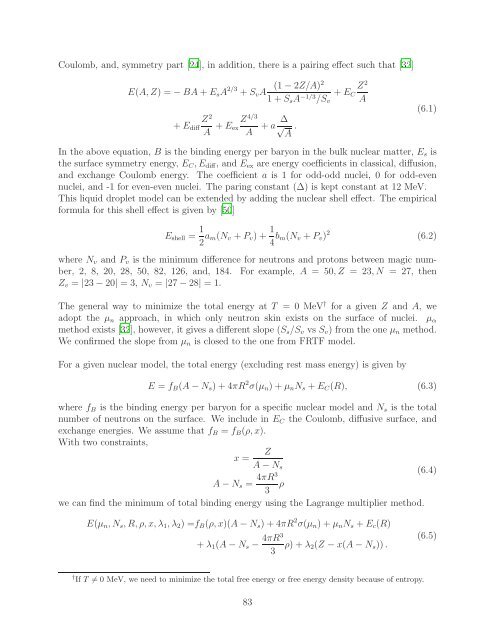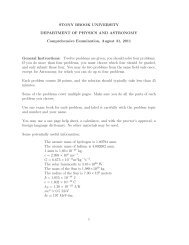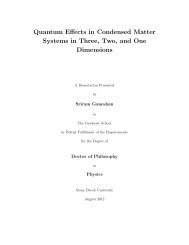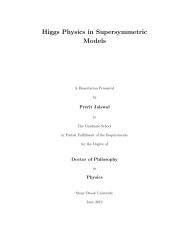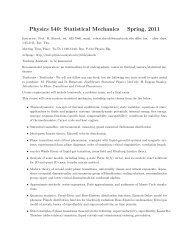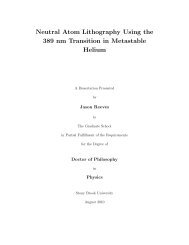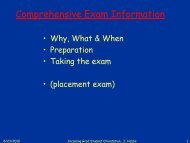Theory of Nuclear Matter for Neutron Stars and ... - Graduate Physics
Theory of Nuclear Matter for Neutron Stars and ... - Graduate Physics
Theory of Nuclear Matter for Neutron Stars and ... - Graduate Physics
Create successful ePaper yourself
Turn your PDF publications into a flip-book with our unique Google optimized e-Paper software.
Coulomb, <strong>and</strong>, symmetry part [24], in addition, there is a pairing effect such that [32]E(A,Z) =−BA+E s A 2/3 +S v A (1−2Z/A)2 Z 2+E1+S s A −1/3 C/S v A+E diffZ 2A +E exZ 4/3A +a ∆ √A.(6.1)In the above equation, B is the binding energy per baryon in the bulk nuclear matter, E s isthe surface symmetry energy, E C ,E diff , <strong>and</strong> E ex are energy coefficients in classical, diffusion,<strong>and</strong> exchange Coulomb energy. The coefficient a is 1 <strong>for</strong> odd-odd nuclei, 0 <strong>for</strong> odd-evennuclei, <strong>and</strong> -1 <strong>for</strong> even-even nuclei. The paring constant (∆) is kept constant at 12 MeV.This liquid droplet model can be extended by adding the nuclear shell effect. The empirical<strong>for</strong>mula <strong>for</strong> this shell effect is given by [50]E shell = 1 2 a m(N v +P v )+ 1 4 b m(N v +P v ) 2 (6.2)where N v <strong>and</strong> P v is the minimum difference <strong>for</strong> neutrons <strong>and</strong> protons between magic number,2, 8, 20, 28, 50, 82, 126, <strong>and</strong>, 184. For example, A = 50,Z = 23,N = 27, thenZ v = |23−20| = 3, N v = |27−28| = 1.The general way to minimize the total energy at T = 0 MeV † <strong>for</strong> a given Z <strong>and</strong> A, weadopt the µ n approach, in which only neutron skin exists on the surface <strong>of</strong> nuclei. µ αmethod exists [32], however, it gives a different slope (S s /S v vs S v ) from the one µ n method.We confirmed the slope from µ n is closed to the one from FRTF model.For a given nuclear model, the total energy (excluding rest mass energy) is given byE = f B (A−N s )+4πR 2 σ(µ n )+µ n N s +E C (R), (6.3)where f B is the binding energy per baryon <strong>for</strong> a specific nuclear model <strong>and</strong> N s is the totalnumber <strong>of</strong> neutrons on the surface. We include in E C the Coulomb, diffusive surface, <strong>and</strong>exchange energies. We assume that f B = f B (ρ,x).With two constraints,Zx =A−N s(6.4)A−N s = 4πR33 ρwe can find the minimum <strong>of</strong> total binding energy using the Lagrange multiplier method.E(µ n ,N s ,R,ρ,x,λ 1 ,λ 2 ) =f B (ρ,x)(A−N s )+4πR 2 σ(µ n )+µ n N s +E c (R)+λ 1 (A−N s − 4πR33 ρ)+λ 2(Z −x(A−N s )).(6.5)† If T ≠ 0 MeV, we need to minimize the total free energy or free energy density because <strong>of</strong> entropy.83


